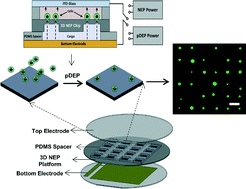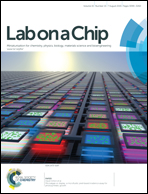Dielectrophoresis-assisted 3D nanoelectroporation for non-viral cell transfection in adoptive immunotherapy†
Abstract
Current transfection technologies lead to significant inter-clonal variations. Previously we introduced a unique electrotransfection technology, Nanochannel-Electroporation (NEP), which can precisely and benignly transfect small cell populations (~100–200 cells) with single-cell resolution. Here we report on the development of a novel 3D NEP system for large scale transfection. A properly-engineered array of nanochannels, capable of handling/transfecting ~60 000 cells cm−2, was fabricated using cleanroom technologies. Positive dielectrophoresis was used to selectively position cells on the nanochannels, thus allowing highly efficient transfection. Single-cell dosage control was demonstrated using both small and large molecules, and different cell types. The potential clinical relevance of this system was tested with difficult-to-transfect natural killer cell suspensions, and plasmids encoding for the chimeric antigen receptor (CAR), a model of high relevance for adoptive immunotherapy. Our results show significantly higher CAR transfection efficiencies for the DEP-NEP system (>70% vs. <30%), as well as enhanced cell viabilities.


 Please wait while we load your content...
Please wait while we load your content...